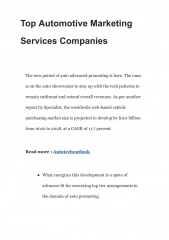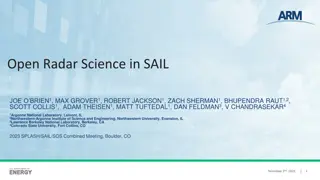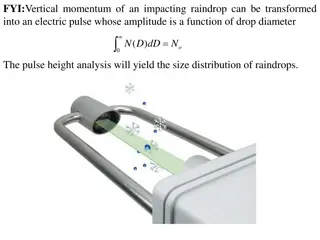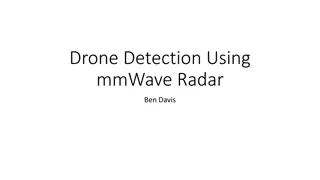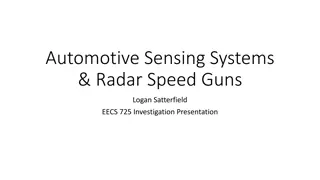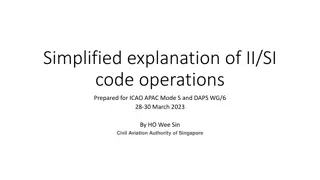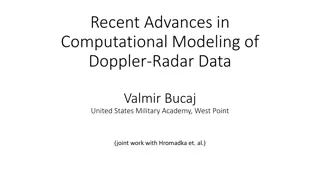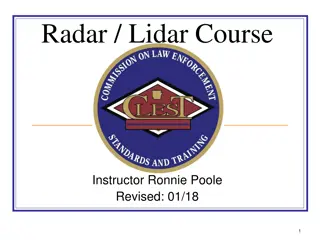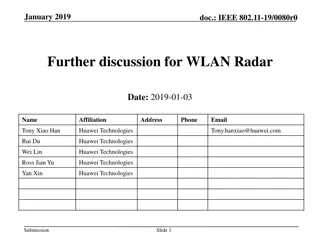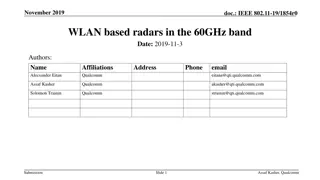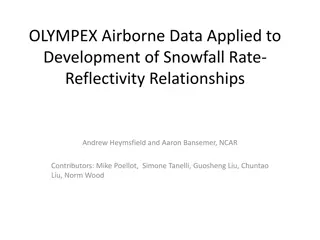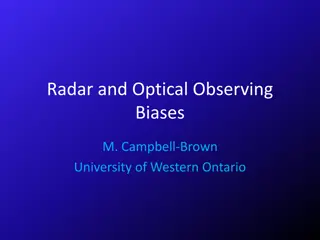Analysis of TI AWR2243 Automotive Radar
This analysis delves into the TI AWR2243 automotive radar, a single-chip transmitter/receiver for FMCW radar with specific technical specifications. It explores the significance of interference in scenarios involving multiple radars, chirp design constraints, and preliminary results in radar technology research. Practical scenarios and constraints are discussed to understand the challenges and considerations in radar system design and operation.
Download Presentation

Please find below an Image/Link to download the presentation.
The content on the website is provided AS IS for your information and personal use only. It may not be sold, licensed, or shared on other websites without obtaining consent from the author.If you encounter any issues during the download, it is possible that the publisher has removed the file from their server.
You are allowed to download the files provided on this website for personal or commercial use, subject to the condition that they are used lawfully. All files are the property of their respective owners.
The content on the website is provided AS IS for your information and personal use only. It may not be sold, licensed, or shared on other websites without obtaining consent from the author.
E N D
Presentation Transcript
A N A L Y S I S O F T I A W R 2 2 4 3 A U T O M O T I V E R A D A R CHRIS ORD
TI AWR2243 Single Chip Transmitter/Receiver for FMCW Radar [1] 76-81 GHz 3 Transmit Channels 4 Receive Channels 13 dBm output power 20 MHz IF Bandwidth 12 dB Rx NF Evaluation Board (TI AWR2243BOOST) [2] Transmit and Receive Antenna Similar to those found in real-world designs Fig 1: Picture of TI AWR2243BOOST [2] [1] Texas Instruments Design Staff, AWR2243 Single-Chip 76- to 81-GHz FMCW Transceiver, Texas Instruments, 2022. [2] AWR2243BOOST, AWR2243BOOST Evaluation board | TI.com, https://www.ti.com/tool/AWR2243BOOST (accessed Nov. 29, 2023).
Portions of Analysis Significance of Interference Two Identical Radars Operating Close to One Another How much greater is interference on victim s receiver compared to desired target return? Chirp Design Constraints What are the constraints when designing chirps in this band? Must consider Maximum unambiguous range Dependent on both SNR and system s IF bandwidth Range Resolution Maximum unambiguous doppler (velocity) Doppler (velocity) resolution Maximum unambiguous angle Angular resolution Can change Number of Chirps per Integration Time Chirp Sweep Bandwidth Chirp Time
Interference Scenario #1 Two cars Red car Red car driving directly behind blue car (no horizontal offset) Transmits FMCW from front of car for early collision detection Signal reflects off blue car and returns to receiver Blue car Transmits FMCW from back of car for rear collision detection Signal directly incident on red car s receiver Technically a small angle between blue car Tx and red car Rx, but is negligible due to wide azimuth beamwidth of antennas used in automotive radars What is the ratio of power at red s receiver from blue s interference to power at red s receiver due to target return? 2[3] 4 3?4 2 4 ? ?????? = ???+ ???+ ??? 10???10 ) [3] ?? ?? = ???+ ???+ ???+ ??? 10???10( [3] Z. Yang and A. Mani, Interference Mitigation For AWR/IWR Devices, Texas Instruments, 2022.
Interference Scenario #2 Three Cars Red Car Driving Directly Behind Green Car (Both In Center of Lane) Blue Car Driving In Lane 1 to Left (In Center of Lane) Assume Lanes Fit NHTSB Standard of 3.7 m lane width for highways, and each car is exactly 1.8 m wide Red Car Transmits FMCW from front of car for early collision detection Signal reflects off green car and returns to receiver Blue Car Transmits FMCW from rear right side of car, pointed at 135 angle relative to direction of traffic Signal Incident on Red car s Rx, but at an angle that does not sit in main beam of red car s radar Fig 2. Azimuth beampattern of AWR2243BOOST board [2] AWR2243BOOST, AWR2243BOOST Evaluation board | TI.com, https://www.ti.com/tool/AWR2243BOOST (accessed Nov. 29, 2023).
Possible SNR With Different Chirp Parameters ????? =???2 2 ??? = 10-20 dBsm for cars, ~0 dBsm for motorcycles [5,6] Looking at worst case scenario, what chirp duration and number of pulses per coherent interval are required for certain SNR at different ranges? 4 3?4??0? [4] [4] C. Allen. EECS 725. Class Lecture, Topic: Radar Measurements II School of Engineering, University of Kansas, Lawrence, KS, Sept. 28, 2023. [5] S. B. Jayapal Gowdu, A. Schwind, R. Stephan, and M. A. Hein, Monostatic RCS measurements of a passenger car mock-up at 77 GHz frequency in virtual environment, 2019 49th European Microwave Conference (EuMC), 2019. doi:10.23919/eumc.2019.8910719 [6] T. Schipper, J. Fortuny-Guasch, D. Tarchi, L. Reichardt, and T. Zwick, RCS Measurement Results for Automotive Related Objects at 23-27 GHz, Proceedings of the 5th European Conference on Antennas and Propagation (EUCAP), pp. 683 686.
Chirp Design Parameters ??????? ? 2 ?????? ???[7] ????= ? ? = 2? [7] 4?? 2??? ????= 7 ? = And more . Use these equations and design space to determine what viable chirp parameters look like Then see what performance is possible with those parameters Or discuss the overall trade space 7 [7] V. Dham, Programming Chirp Parameters in TI Radar Devices, Texas Instruments, 2020.


